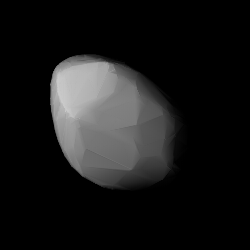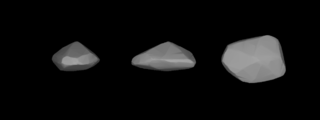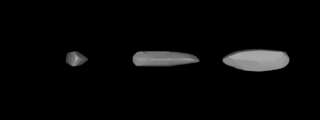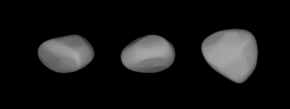
1566 Icarus is a large near-Earth object of the Apollo group and the lowest numbered potentially hazardous asteroid. It has an extremely eccentric orbit (0.83) and measures approximately 1.4 km (0.87 mi) in diameter. In 1968, it became the first asteroid ever observed by radar. Its orbit brings it closer to the Sun than Mercury and further out than the orbit of Mars, which also makes it a Mercury-, Venus-, and Mars-crossing asteroid. This stony asteroid and relatively fast rotator with a period of 2.27 hours was discovered on 27 June 1949, by German astronomer Walter Baade at the Palomar Observatory in California. It was named after the mythological Icarus.

144 Vibilia is a carbonaceous asteroid from the central region of the asteroid belt, approximately 140 kilometers in diameter. It was discovered on 3 June 1875, by German–American astronomer Christian Peters at Litchfield Observatory of the Hamilton College in Clinton, New York, United States. Peters named it after Vibilia, the Roman goddess of traveling, because he had recently returned from a journey across the world to observe the transit of Venus. Peters also discovered 145 Adeona on the same night. The official naming citation was published by Paul Herget in The Names of the Minor Planets in 1955.

1685 Toro is an asteroid and near-Earth object of the Apollo group on an eccentric orbit. It was discovered on 17 July 1948, by American astronomer Carl Wirtanen at Lick Observatory on Mount Hamilton, California. The stony S-type asteroid has a rotation period of 10.2 hours and measures approximately 4 kilometers in diameter. It is named for Betulia Toro Herrick, wife of astronomer Samuel Herrick. The Sylacauga meteorite appears to have originated from this asteroid.

2100 Ra-Shalom is an asteroid and near-Earth object of the Aten group on an eccentric orbit in the inner Solar System. It was discovered on 10 September 1978, by American astronomer Eleanor Helin at the Palomar Observatory, California, who named it in commemoration of the Camp David Peace Accords. The C-type asteroid has a rotation period of 19.8 hours and measures approximately 2.7 kilometers in diameter.

512 Taurinensis, provisional designation 1903 LV, is a stony asteroid and large Mars-crosser on an eccentric orbit from the inner regions of the asteroid belt, approximately 20 kilometers in diameter. It was discovered on 23 June 1903, by astronomer Max Wolf at the Heidelberg-Königstuhl State Observatory in southwest Germany. The asteroid was named after the Italian city of Turin. It is the 4th-largest Mars-crossing asteroid.
517 Edith, provisional designation 1903 MH, is a carbonaceous background asteroid from the outer regions of the asteroid belt, approximately 83 kilometers in diameter. It was discovered on 22 September 1903, by American astronomer Raymond Dugan at the Heidelberg-Königstuhl State Observatory in southwest Germany, who named it after his sister Edith Eveleth.
779 Nina is a large background asteroid, approximately 80 kilometers in diameter, located in the central region of the asteroid belt. It was discovered on 25 January 1914, by Russian astronomer Grigory Neujmin(1886-1946) at the Simeiz Observatory on the Crimean peninsula. The metallic X-type asteroid with an intermediate albedo has a rotation period of 11.2 hours. It was named after the discoverer's sister, Nina Neujmina (Tsentilovich) (1889–1971).

1627 Ivar is an elongated stony asteroid and near-Earth object of the Amor group, approximately 15×6×6 km. It was discovered on 25 September 1929, by Danish astronomer Ejnar Hertzsprung at Leiden Southern Station, annex to the Johannesburg Observatory in South Africa. It was named after Ivar Hertzsprung, brother of the discoverer. 1627 Ivar was the first asteroid to be imaged by radar, in July 1985 by the Arecibo Observatory.
1863 Antinous, provisional designation 1948 EA, is a stony asteroid and near-Earth object, approximately 2–3 kilometers in diameter. It was discovered on 7 March 1948 by American astronomer Carl Wirtanen at Lick Observatory on the summit of Mount Hamilton, California. It was named after Antinous from Greek mythology.

1865 Cerberus is a stony asteroid and near-Earth object of the Apollo group, approximately 1.6 kilometers in diameter. It was discovered on 26 October 1971, by Czech astronomer Luboš Kohoutek at the Hamburger Bergedorf Observatory, Germany, and given the provisional designation 1971 UA. It was named for Cerberus from Greek mythology.
3757 Anagolay, provisional designation 1982 XB, is a highly eccentric asteroid, classified as a potentially hazardous asteroid and a near-Earth object of the Amor group, approximately half a kilometer in diameter. It was discovered on 14 December 1982, by American astronomer Eleanor Helin at the Palomar Observatory in California, United States. The asteroid was named after Anagolay from Philippine mythology.
14827 Hypnos is a highly eccentric, sub-kilometer-sized carbonaceous asteroid that is thought to be an extinct comet. It is classified as near-Earth object and potentially hazardous asteroid of the Apollo group.
1943 Anteros, provisional designation 1973 EC, is a spheroidal, rare-type asteroid and near-Earth object of the Amor group, approximately 2 kilometers in diameter.
2363 Cebriones is a large Jupiter trojan from the Trojan camp, approximately 84 kilometers in diameter. It was discovered on 4 October 1977, by astronomers at the Purple Mountain Observatory in Nanking, China. The dark D-type asteroid is one of the 40 largest Jupiter trojans and has a rotation period of 20 hours. It was named after Cebriones, Hektor's charioteer from Greek mythology.
1722 Goffin, provisional designation 1938 EG, is a stony asteroid from the central region of the asteroid belt, approximately 10.3 kilometers in diameter.
3102 Krok, provisional designation 1981 QA, is a rare-type asteroid and slow rotator, classified as a near-Earth object of the Amor group, that measures approximately 1.5 kilometers in diameter.
3199 Nefertiti, provisional designation 1982 RA, is a rare-type asteroid, classified as near-Earth object of the Amor group of asteroids, approximately 2.2 kilometers in diameter. It was discovered on 13 September 1982, by American astronomer couple Carolyn and Eugene Shoemaker at Palomar Observatory, California, United States.
2201 Oljato, provisional designation 1947 XC, is a stony and extremely eccentric active asteroid and sizable near-Earth object of the Apollo group, approximately 2 kilometers in diameter. It has an Earth minimum orbit intersection distance of 0.0031 AU (460 thousand km) and is associated with the Beta Taurids daytime meteor shower.
3288 Seleucus, provisional designation 1982 DV, is a rare-type stony asteroid, classified as near-Earth object of the Amor group of asteroids, approximately 2.5 kilometers in diameter. It was discovered on 28 February 1982, by German astronomer Hans-Emil Schuster at ESO's La Silla Observatory site in northern Chile. It was named after the Hellenistic general and Seleucid ruler Seleucus I Nicator.
1915 Quetzálcoatl, provisional designation 1953 EA, is a very eccentric, stony asteroid classified as near-Earth object, about half a kilometer in diameter. It was discovered on 9 March 1953, by American astronomer Albert George Wilson at Palomar Observatory, California. It was named for Quetzalcoatl from Aztec mythology.







